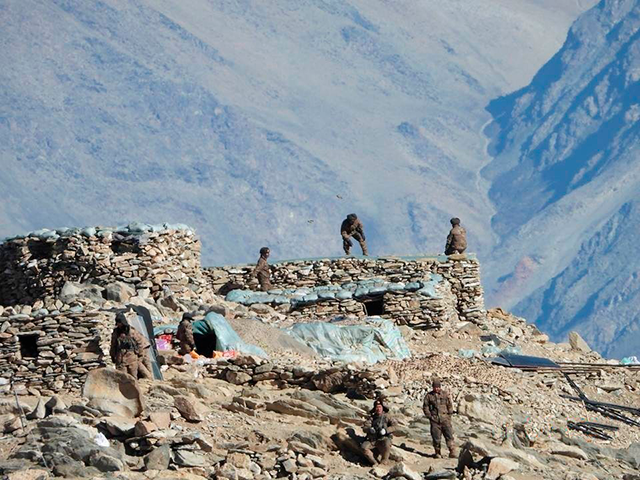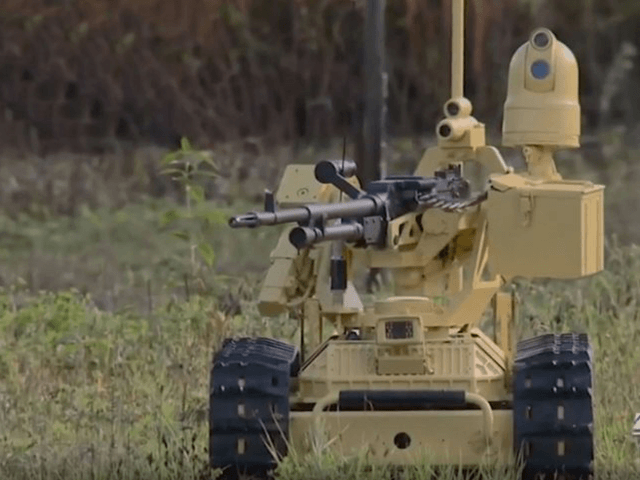The Chinese military is reportedly moving a large number of unmanned ground vehicles into the Tibetan plateau, taking over duties from ethnic Han soldiers in the People’s Liberation Army (PLA) who have trouble coping with the cold temperatures and thin air of Tibet.
A report from India’s Times Now News on Tuesday said over half of China’s robot vehicles are headed for Ladakh, the region where China is facing off against the Indian military over a disputed border.
Both China and India fortified their military presence in Ladakh after a deadly hand-to-hand battle in the Galwan river valley in June 2020. China’s buildup was more industrialized and technologically sophisticated, but also plagued from its early days by reports of Chinese soldiers having considerably more difficulty adapting to the Himalayas than their Indian counterparts.

This photograph provided by the Indian Army, according to them shows Chinese troops dismantling their bunkers at Pangong Tso region, in Ladakh along the India-China border on Monday, Feb.15, 2021.(Indian Army via AP)
The Chinese were reportedly spotted using “all-terrain walking excavators” – remote-controlled spider-like construction robots – to build roads along the Himalayan border. At the end of 2020, Chinese state media reported its Himalayan troops were given exoskeleton suits to help them “conduct tasks in harsh, high-altitude environments more efficiently.”
According to Times Now News, the PLA’s Tibetan command has given up on cyborgs and gone straight to killer robots:
The PLA has moved 88 Sharp Claw unmanned ground vehicles or UGVs into Tibet, and 38 of them in the western part of the province, close to where the Indian and Chinese armies are still face to face. The Sharp Claw UGV, manufactured by NORINCO, a Chinese arms manufacturer, can be used for reconnaissance, patrolling and transportation of weapons and logistical work in difficult terrain. it can also be fitted with weapons.
Also in Tibet is the robotized Mule-200, manufactured by Zhong Tian Zhu Kong Technology Holdings. It has a range of 50 km, can navigate difficult terrain and also, carry about 200 kg of ammunition, supplies or even weapons at a time. Remotely controlled by wireless, it can perform combat tasks if fitted out for fire-support activities. The PLA has 120 Mule-200s in Tibet, more than half of which are in the western areas.
Chinese Army using robot vehicles in Tibet.#China #Tibet https://t.co/6G3pUAaxeS
— TIMES NOW (@TimesNow) December 28, 2021
The Sharp Claw UGV looks like a heavily-armed lawn mower equipped with tank treads, cameras, and a machine gun. According to its manufacturer China North Industries Corporation (Norinco), it can engage targets without human intervention using its 7.62mm light machine gun. The Sharp Claw officially entered service with the PLA in the spring of 2020.
Norinco also makes the Sharp Claw 2, a larger UGV about the size of a car with six wheels that can carry and deploy the smaller, shorter-range Sharp Claw 1.
The Mule-200 is a half-ton multi-function robot tractor that uses a hybrid gas/electric engine to increase its range, haul more cargo, and operate in rough terrain. As Times Now News noted, the Mule-200 can be configured to carry weapons.
The Chinese are also reportedly moving a large number of Lynx all-terrain vehicles closer to its potential conflict zone with India. The Lynx is an uncomfortable-looking eight-wheeled troop carrier with a human driver. A militarized version of a civilian ATV design, the Lynx can carry five passengers or a small amount of equipment. The PLA has been observed experimenting with armed variations of the Lynx, usually sporting grenade launchers, multiple-launch artillery rockets, or a heavy machine gun.
Even as it planned to replace its human soldiers with robots, the Chinese government has striven to convey total confidence in its Himalayan forces. Dictator Xi Jinping singled out the Tibetan border battalion for special praise in September, writing the unit a letter of commendation that applauded the “great job” it has done over the past five years and “encouraging them to make new contributions to the Party and the people.”
Xi designated the border unit as a “model plateau battalion” and praised its “outstanding performance in safeguarding borders, ensuring stability, and helping disaster relief.”
Also in September, PLA troops in the “Tibet Military District” conducted a show-of-force military exercise specifically intended to intimidate India.
The demonstration showed the PLA using combined infantry, artillery, air support, special operations troops, electronic warfare, and combat engineers to swiftly take control of an enemy command center.
The drill was also reportedly intended to show the Indians that China’s air power and missile defenses are fully functional in the high-altitude Himalayan theater.

COMMENTS
Please let us know if you're having issues with commenting.